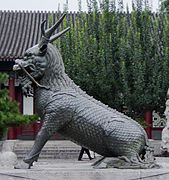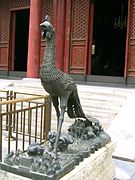Siling (mythology)
| Siling | |
|---|---|
| Chinese phoenix , Longshan Temple | |
| Chinese name | |
| Long characters | 四 靈 |
| Abbreviation | 四 灵 |
| Pinyin | sìlíng |
| Jyutping | be 5 ling 4 |
| Alternative name | |
| Long characters | 四 瑞 |
| Abbreviation | 四 瑞 |
| Pinyin | sìruì |
| Jyutping | be 3 seoi 6 |
| Japanese name | |
| Kanji | 四 霊 |
| Kana | し れ い |
| Hepburn | shirei |
| Alternative name | |
| Kanji | 四 瑞 |
| Kana | し ず い |
| Hepburn | shizui |
| Korean name | |
| Hangeul | 사령 |
| Hanja | 四 靈 |
| MR | saryŏng |
| RR | saryeong |
| Vietnam. designation | |
| Chữ Quốc Ngữ | Tứ Linh |
| Chữ Nôm | 四 靈 |
| Alternative name | |
| Chữ Quốc Ngữ | Tứ Thánh Thú |
Siling , also Si Ling , ( Chinese 四 靈 / 四 灵 - "Four animated beings, four auspicious animals, four powerful beings, four sacred animals, four magical beings or four miracle animals"), describes the four central mythical creatures of the Chinese-East Asian as a collective term Mythology :
These four mythological animals are revered as benevolent and good luck. According to the legend, they are said to have already helped the primordial being Pangu with the creation of the world and later lived in the garden of the Yellow Emperor .
The Si Ling have been identified on ceramic tiles as early as the Warring States' era . They are not to be confused with the four symbols Si Xiang ( 四象 , Sì Xiàng - "four appearances") - blue dragon , red bird , white tiger , black turtle - which in Chinese astronomy symbolize the four cardinal points and sometimes also as " Miracle animals ”. Sometimes the Si Ling are also seen as the terrestrial counterpart to the heavenly Si Xiang .
Occasionally - based on the five elements - the white tiger was added to the Si Ling , one then speaks of the Wu Ling ( 五 靈 / 五 灵 ), the five animated beings.
Individual evidence
- ↑ Term "siling (四 靈 / 四 灵)", Chinese: [1] on www.zdic.net, accessed on November 4, 2017 - online
- ↑ Term "siling (四 靈 / 四 灵)", Chinese: [2] on dict.revised.moe.edu.tw, accessed on November 4, 2017 - online
- ↑ term "shirei (四霊/しれい)", English - Japanese: [3] on tangorin.com, accessed on November 4, 2017 - Online
- ↑ Term "shizui (四 瑞 / し ず い)", English - Japanese: [4] on tangorin.com, accessed on June 1, 2020 - online
- ↑ Irmgard Enzinger: Expression and impression: for the Chinese understanding of the senses , Otto Harrassowitz Verlag, 2006, p. 206f
- ↑ Jutta Bewig, Ellen Hickmann (ed.): Wegweiser zur Völkerkunde , issues 21–24, Hamburgisches Museum für Völkerkunde, p. 96
- ↑ a b Bruno Voigt, Yang En-lin: On the use and technology of Chinese roof tiles , In: Research and reports of the Staatliche Museen zu Berlin, Volume 10 , Akademie-Verlag, 1968, p. 223
- ^ Roel Sterckx: The Animal and the Daemon in Early China , Suny Press, 2012, p. 103
- ↑ Christoph Kaderas: The Leishu of the Imperial Library of the Emperor Qianlong (r. 1736-1796): Investigations on the Chinese Encyclopedia , Otto Harrassowitz Verlag, 1998, pp. 145, 155




